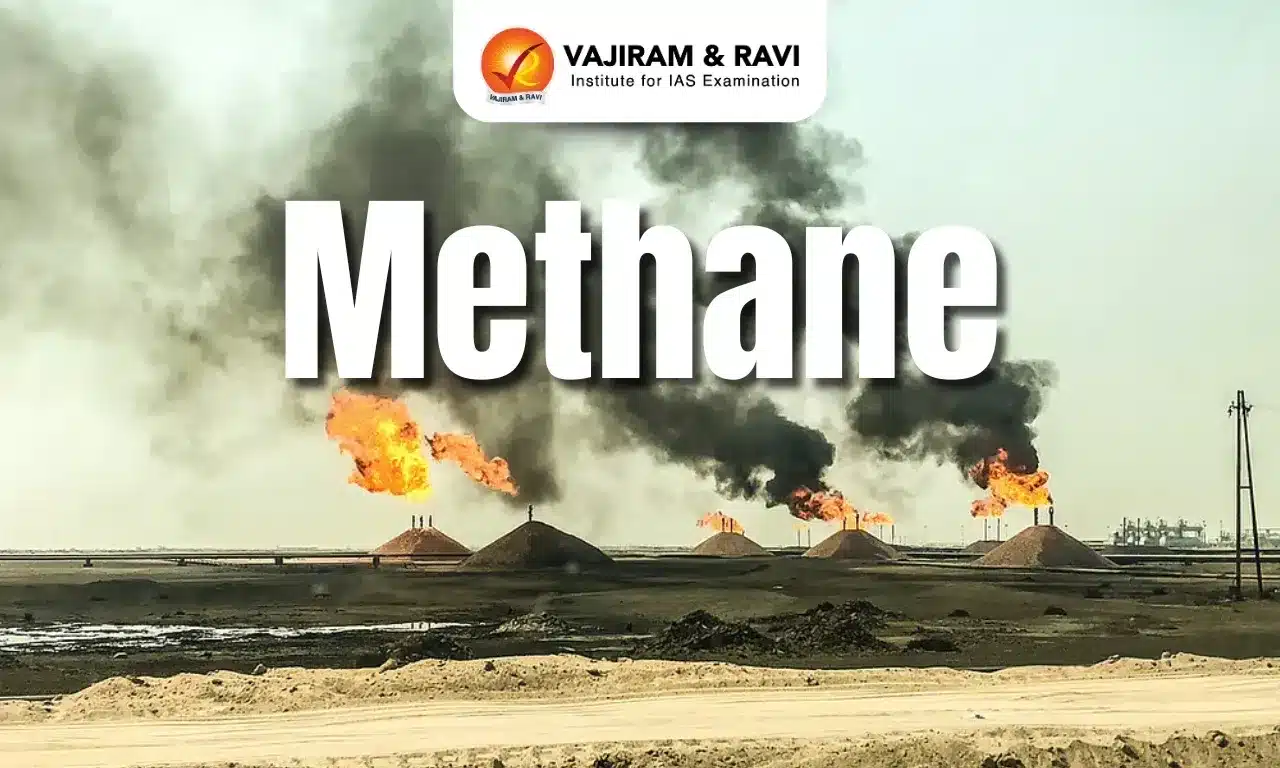Methane Latest News
According to the International Energy Agency’s (IEA) Global Methane Tracker 2025, the energy sector contributed approximately 145 million tonnes (Mt) of methane emissions in 2024, with oil and gas facilities alone accounting for over 80 Mt.
About Methane
- Methane is a potent greenhouse gas, responsible for about 30% of the global temperature rise since the Industrial Revolution. Its atmospheric concentration is now 2.5 times higher than in the preindustrial era and is rising faster than other greenhouse gases.
- The three major anthropogenic sources of methane emissions are agriculture, energy, and waste sectors.
- The energy sector — comprising oil, natural gas, coal, and bioenergy — accounts for over 35% of human-induced methane emissions.
- Within the energy sector:
- Oil operations contributed around 45 Mt.
- Natural gas operations released nearly 35 Mt.
- Abandoned oil and gas wells emitted approximately 3 Mt.
- Coal activities added more than 40 Mt, including 4 Mt from abandoned mines.
- Bioenergy combustion, especially in developing countries, contributed 18 Mt, mostly from traditional biomass like wood, dung, and charcoal.
- Methane Characteristics:
- It is a colourless, odourless, and highly flammable gas, also known as marsh gas.
- It has a short atmospheric lifespan of ~10 years but a Global Warming Potential (GWP) of ~80 times that of CO₂ over 20 years.
- Around 60% of atmospheric methane comes from human activities; the rest is from natural sources like wetlands and permafrost thawing, which release methane and CO₂ as temperatures rise.
- End-use equipment in energy systems also leaks methane — contributing an additional 2 Mt.
- Modern bioenergy sources contributed ~2 Mt of methane. These include biogas, biomethane, and biofuels derived from plant residues and waste.
- The IEA highlighted that ~70% of fossil fuel methane emissions can be mitigated using existing technologies, and in oil & gas, ~75% of emissions can be reduced by fixing leaks and plugging abandoned wells.
- China, followed by the USA, Russia, Iran, Turkmenistan, and India, are the top emitters from fossil fuel operations.
Methane FAQs
Q1: What is methane, and why is it significant in climate discussions?
Ans: Methane (CH₄) is a potent greenhouse gas, with a global warming potential about 80 times greater than CO₂ over 20 years.
Q2: What are the major sources of methane emissions?
Ans: Major sources include livestock digestion (enteric fermentation), rice paddies, landfills, and oil and gas operations.
Q3: Which global initiative targets methane reduction?
Ans: The Global Methane Pledge, launched at COP26, aims to reduce global methane emissions by at least 30% by 2030.
Source: DTE
Last updated on July, 2025
→ UPSC Notification 2025 was released on 22nd January 2025.
→ UPSC Prelims Result 2025 is out now for the CSE held on 25 May 2025.
→ UPSC Prelims Question Paper 2025 and Unofficial Prelims Answer Key 2025 are available now.
→ UPSC Calendar 2026 is released on 15th May, 2025.
→ The UPSC Vacancy 2025 were released 1129, out of which 979 were for UPSC CSE and remaining 150 are for UPSC IFoS.
→ UPSC Mains 2025 will be conducted on 22nd August 2025.
→ UPSC Prelims 2026 will be conducted on 24th May, 2026 & UPSC Mains 2026 will be conducted on 21st August 2026.
→ The UPSC Selection Process is of 3 stages-Prelims, Mains and Interview.
→ UPSC Result 2024 is released with latest UPSC Marksheet 2024. Check Now!
→ UPSC Toppers List 2024 is released now. Shakti Dubey is UPSC AIR 1 2024 Topper.
→ Also check Best IAS Coaching in Delhi















